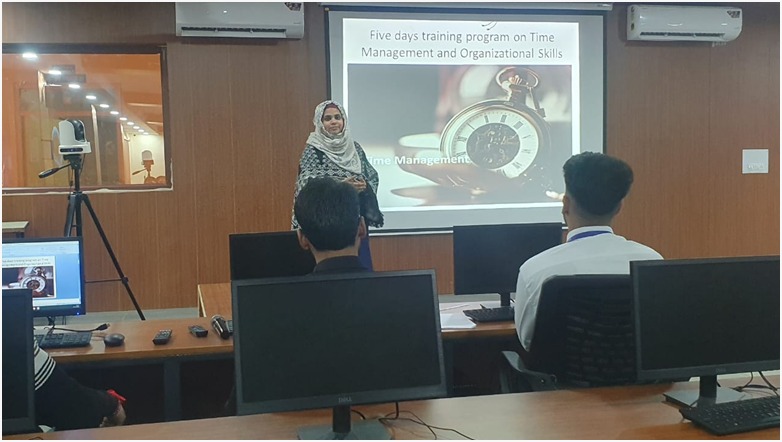Artificial Intelligence AND MACHINE LEARNING
The goal of the Department of Artificial Intelligence and Machine Learning is to produce highly knowledgeable, competent and resourceful young engineers, who have an effective skill set for growth.
Artificial Intelligence and Machine Learning focuses on research to create machines that attempt to solve problem and analyze contradictory or ambiguous information. Topics covered in this category include artificial intelligence technologies, such as, expert systems, fuzzy systems, natural language processing, speech recognition, pattern recognition, computer vision, decision-support systems, knowledge bases and neural networks.
Artificial Intelligence and Machine learning is at the forefront of developing intelligent solutions to real-life problems. As our technology-laden society increasingly relies on digital data, machine learning is crucial for most of our current and future applications. Engineers with AI expertise would be needed in all the crucial domains such as Healthcare, Industry 5.0, Finance, Agriculture, Security, Law, and Environment Management in the near future.
Our faculty and students are actively engaged in application-based projects and research projects with industry, R&D labs and research centers. The program offers the opportunity for the overall development of the students via internships; industry co-teaching, certificate programs, workshops and project based teaching-learning pedagogy.
The training doesn’t stop here; students are groomed on personality aspect as well, throughout their program duration, right up till their placement.

VISION
To be in the pioneer of Artificial Intelligence and Machine Learning to create innovative engineers with
moral values in a myriad of application areas in industry & research.
MISSION
- To groom the students with the quality of technical skill, who will be able to create, share and apply their knowledge in multidisciplinary areas for the benefit of society.
- To expertise the students in advanced technology thereby promoting research.
- To pursue excellence in Industry Institute Interaction program for students to get acquainted with corporate culture.
- To impart moral, ethical values and interpersonal skills to the students.
 The Department of Artificial Intelligence & Machine Learning has recorded as emerging and renowned department. It is sure that this department is going to be evolving and constantly will get into pace with the developing world. This department was established in 2021 with JBIT institute. This department is established with an objective of highly equipped and innovative research oriented laboratories in future. Artificial Intelligence & Machine Learning has qualified faculties including doctorate and post-graduates. Here undergraduates are motivated and encouraged to take up minor projects with are mainly Artificial Intelligence based. We also practice industries based practices, value added courses and well planned lectures. We also encourage students for participative, experiential and various kind of learning so that they could achieve the best. We encourage our faculties to attend conferences, faculties development programmes and other such programmes that could change and improve their profile orthogonally. Rest, I wish best to my students for their future endeavours and great success.
The Department of Artificial Intelligence & Machine Learning has recorded as emerging and renowned department. It is sure that this department is going to be evolving and constantly will get into pace with the developing world. This department was established in 2021 with JBIT institute. This department is established with an objective of highly equipped and innovative research oriented laboratories in future. Artificial Intelligence & Machine Learning has qualified faculties including doctorate and post-graduates. Here undergraduates are motivated and encouraged to take up minor projects with are mainly Artificial Intelligence based. We also practice industries based practices, value added courses and well planned lectures. We also encourage students for participative, experiential and various kind of learning so that they could achieve the best. We encourage our faculties to attend conferences, faculties development programmes and other such programmes that could change and improve their profile orthogonally. Rest, I wish best to my students for their future endeavours and great success.
With Best Wishes,
Dr.Shagufta Praveen
Head – Department AI & ML
JB Institute of Technology Dehradun
Mail: hod-aiml@jbitdoon.edu.in
Mobile : +91-6388854168
| S.NO. | Faculty Name | Designation | Qualification |
|---|---|---|---|
| 1 | Dr. Shagufta Praveen | Assistant Professor | PhD |
| 2 | Mr. Danish | Assistant Professor | M. Tech |
| 3 | Ms. Tanya Chandra | Assistant Professor | M. Tech |
| 4 | Mr. Shivam Pandey | Assistant Professor | M. Tech |
| 5 | Mr. Pradeep Kaushik | Assistant Professor | M. Tech |
| 6 | Mr. Atul Bhandari | Assistant Professor | M. Tech |
| AIML Syllabus | View. |
|---|
Program Specific Outcomes and Program Educational Objectives
 Engineering knowledge: Apply the knowledge of mathematics, science, engineering fundamentals, and an engineering specialisation for the solution of complex engineering problems.
Engineering knowledge: Apply the knowledge of mathematics, science, engineering fundamentals, and an engineering specialisation for the solution of complex engineering problems.
 Problem analysis: Identify, formulate, research literature, and analyse complex engineering problems reaching substantiated conclusions using first principles of mathematics, natural sciences, and engineering sciences.
Problem analysis: Identify, formulate, research literature, and analyse complex engineering problems reaching substantiated conclusions using first principles of mathematics, natural sciences, and engineering sciences.
 Design/Development of Solutions: Design solutions for complex engineering problems and design system components or processes that meet the specified needs with appropriate consideration for public health and safety, and cultural, societal, and environmental considerations.
Design/Development of Solutions: Design solutions for complex engineering problems and design system components or processes that meet the specified needs with appropriate consideration for public health and safety, and cultural, societal, and environmental considerations.
 Conduct investigations of complex problems: Use research-based knowledge and research methods including design of experiments, analysis and interpretation of data, and synthesis of the information to provide valid conclusions.
Conduct investigations of complex problems: Use research-based knowledge and research methods including design of experiments, analysis and interpretation of data, and synthesis of the information to provide valid conclusions.
 Modern tool usage: Create, select, and apply appropriate techniques, resources, and modern engineering and IT tools including prediction and modelling to complex engineering activities with an understanding of the limitations.
Modern tool usage: Create, select, and apply appropriate techniques, resources, and modern engineering and IT tools including prediction and modelling to complex engineering activities with an understanding of the limitations.
 The engineer and society: Apply reasoning informed by the contextual knowledge to assess societal, health, safety, legal, and cultural issues and the consequent responsibilities relevant to the professional engineering practice.
The engineer and society: Apply reasoning informed by the contextual knowledge to assess societal, health, safety, legal, and cultural issues and the consequent responsibilities relevant to the professional engineering practice.
 Environment and sustainability: Understand the impact of the professional engineering solutions in societal and environmental contexts, and demonstrate the knowledge of, and the need for sustainable development.
Environment and sustainability: Understand the impact of the professional engineering solutions in societal and environmental contexts, and demonstrate the knowledge of, and the need for sustainable development.
 Ethics: Apply ethical principles and commit to professional ethics and responsibilities and norms of the engineering practice
Ethics: Apply ethical principles and commit to professional ethics and responsibilities and norms of the engineering practice
 Individual and team work: Function effectively as an individual, and as a member or leader in diverse teams, and in multidisciplinary settings.
Individual and team work: Function effectively as an individual, and as a member or leader in diverse teams, and in multidisciplinary settings.
 Communication: Communicate effectively on complex engineering activities with the engineering community and with the society at large, such as being able to comprehend and write effective reports and design documentation, make effective presentations, and give and receive clear instructions
Communication: Communicate effectively on complex engineering activities with the engineering community and with the society at large, such as being able to comprehend and write effective reports and design documentation, make effective presentations, and give and receive clear instructions
 Project management and finance: Demonstrate knowledge and understanding of the engineering and management principles and apply these to one’s work, as a member and leader in a team, to manage projects and in multidisciplinary environments.
Project management and finance: Demonstrate knowledge and understanding of the engineering and management principles and apply these to one’s work, as a member and leader in a team, to manage projects and in multidisciplinary environments.
 Life-long learning: Recognise the need for, and have the preparation and ability to engage in independent and life-long learning in the broadest context of technological change.
Life-long learning: Recognise the need for, and have the preparation and ability to engage in independent and life-long learning in the broadest context of technological change.
 Ability to contribute to problem identification, analysis, design, and development of systems using principles and concepts of Artificial Intelligence and Machine Learning.
Ability to contribute to problem identification, analysis, design, and development of systems using principles and concepts of Artificial Intelligence and Machine Learning.

Ability to apply the concepts, principles and practices of Artificial Intelligence and Machine Learning and critically evaluate the results with proper arguments, selection of tools and techniques when subjected to loosely defined scenarios.
 Ability to use Artificial Intelligence & Machine Learning models n data for
Ability to use Artificial Intelligence & Machine Learning models n data for
enabling better decision making.
 The graduates will utilize their expertise in Engineering to solve industry’s technological problems.
The graduates will utilize their expertise in Engineering to solve industry’s technological problems.
 Analyse real-life problems, design appropriate system to provide technically sound, economically feasible, and socially acceptable solutions.
Analyse real-life problems, design appropriate system to provide technically sound, economically feasible, and socially acceptable solutions.
 Exhibit professionalism, ethical attitude, communication skills, teamwork in their profession and adapt to current trends by engaging in lifelong learning.
Exhibit professionalism, ethical attitude, communication skills, teamwork in their profession and adapt to current trends by engaging in lifelong learning.
| S. NO | Subject Name | Subject Code | Course Outcome |
|---|---|---|---|
| 1. | Advanced Applied Mathematics | (AHT-006) | COURSE OUTCOMES: After completion of the course student will be able to: 1. Remember the concept of Laplace transform and apply in solving real life problems. 2. Apply the concept of Fourier transform to evaluate engineering problems. 3. Understand to evaluate roots of algebraic and transcendental equations. 4. Solve the problem related interpolation, differentiation, integration and the solution of differential equations. 5. Understand the concept of correlation, regression, moments, skewness and kurtosis and curve fitting. |
| DIGITAL ELECTRONICS | (ECT-033) | COURSEOUTCOMES: After completion of the course student will be able to: 1. Understand the Boolean algebra and minimization of digital functions. 2. Design and implement various combinational circuits. 3. Design and implement various sequential circuits. 4. Understand the digital logic families, semiconductor memories. 5. Design the digital circuits using VHDL |
|
| Technical Communication | (AHT-007) | COURSE OUTCOMES: Students will be enabled to understand the nature and objective of Technical Communication relevant for the work place as Engineers. 1. Students will utilize the technical writing for the purposes of Technical Communication and its exposure in various dimensions. 2. Students would imbibe inputs by presentation skills to enhance confidence in face of diverse audience. 3. Technical communication skills will create a vast know-how of the application of the learning to promote their technical competence. 4. It would enable them to evaluate their efficacy as fluent & efficient communicators by learning the voice-dynamics. |
|
| UNIVERSAL HUMAN VALUES | (AHT-008) | COURSE OUTCOMES: On successful completion of the course, the student will be able to: 1. Expected to become more aware of themselves, and their surroundings (family, society, nature) 2. Become more responsible in life, and in handling problems with sustainable solutions, while keeping human relationships and human nature in mind. 3. Have better critical ability. 4. Become sensitive to their commitment towards what they have understood (human values, human relationship and human society). 5. Able to apply what they have learnt to their own self in different day-to- day settings in real life, at least a beginning would be made in this direction. |
|
| DISCRETE STRUCTURE | (CST-002) | COURSE OUTCOMES: On successful completion of the course, the student will be able to: 1. Develop new models to represent and interpret the data. 2. Apply knowledge of mathematics, probability & statistics, graph theory and logics. 3. Interpret statements presented in disjunctive normal form and determine their validity by applying the rules and methods of propositional calculus. 4. Reformulate statements from common language to formal logic using the rules of propositional and predicate calculus. 5. Apply graph theory in solving computing problems. |
|
| DATA STRUCTURES AND ALGORITHMS | (CST-003) | Course Outcomes: On successful completion of the course, the student will be able to: 1. Compare functions using asymptotic analysis and describe the relative merits of worst-case, average- case, and best-case analysis. 2. Become familiar with a variety of sorting algorithms and their performance characteristics (e.g., running time, stability, space usage) and be able to choose the best one under a variety of requirements. 3. Understand and identify the performance characteristics of fundamental algorithms and data structures and be able to trace their operations for problems such as sorting, searching, selection, operations on numbers, and graphs. 4. Solve real-world problems using arrays, stacks, queues, and linked lists. 5. Become familiar with the major graph algorithms and their analyses. Employ graphs to model engineering problems when appropriate. |
|
| DATABASE MANAGEMENT SYSTEMS | (CST-011) | COURSE OUTCOMES: On successful completion of the course, the student will be able to: 1. Write relational algebra expressions for that query and optimize the developed expressions. 2. Design the databases using E-R method and normalization. 3. Understand the concepts of function dependencies and various normal forms. 4. Understand the concept of transaction atomicity, consistency, isolation, and durability properties in context of real life examples. 5. Develop the understanding of query processing and advanced databases.. |
|
| DATA STRUCTURES AND ALGORITHMS LAB | (CSP-003) | Course Outcomes: On successful completion of the course, the student will be able to: 1. Develop programs using dynamic memory allocation and linked list ADT. 2. Apply Stack and Queue to solve problems. 3. Implement the concept of hashing in real-time dictionaries. 4. Identify and implement suitable data structures for the given problem. 5. Solve real-world problems by finding the minimum spanning tree and the shortest path algorithm. |
|
| DATABASE MANAGEMENT SYSTEM LAB | (CSP-011) | COURSE OUTCOMES: On successful completion of the course, the students will be able to 1. Understand, appreciate, and effectively explain the concepts of database Technologies. 2. Declare and enforce integrity constraints on a database using RDBMS. 3. Devise a complex query using SQL DML/DDL commands. 4. Create views and use in-built functions to query a database. 5. Write PL/SQL programs including stored procedures, stored functions and triggers. |
|
| PYTHON PROGRAMMING LAB | (CSP-005) | COURSE OUTCOMES: On successful completion of the course, the student will be able to: 1. Demonstrate the basic concepts of python programming with the help of data types, operators and expressions, and console input/output. 2. Apply the concept of Control Structures in Python to solve any given problem. 3. Demonstrate operations on built-in container data types (list, tuple, set, dictionary) and strings. 4. Ability to explore python, especially the object-oriented concepts and the built-in objects of Python. 5. Implement the concepts of file handling using packages. |
|
| INTERNSHIP-I/MINI PROJECT-I | (AIP-001) | COURSE OUTCOMES: On successful completion of the course, the student will be able to: 1. Understand organizational issues and their impact on the organization and employees. 2. Identify industrial problems and suggest possible solutions. 3. Relate, apply and adapt relevant knowledge, concepts and theories within an industrial organization, practice and ethics. 4. Apply technical knowledge in an industry to solve real world problems. 5. Demonstrate effective group communication, presentation, self-management, and report writing skills. |
|
| PYTHON PROGRAMMING | (CST-005) | Course Outcomes: On successful completion of the course, the student will be able to: 1. Develop essential programming skills in computer programming concepts like data types. 2. Examine Python syntax and semantics and be fluent in the use of Python flow control and functions. 3. Illustrate the process of structuring the data using lists, tuples, and dictionaries. 4. Demonstrate using built-in functions and operations to navigate the file system. 5. Interpret the concepts of modules and user-defined functions in Python. |
|
| CYBER SECURITY | (CST-006) | Course Outcomes: On successful completion of the course, the student will be able to: 1. Understand cyber-attacks and types of cybercrimes, and familiarity with cyber forensics 2. Realize the importance of cyber security and various forms of cyber-attacks and countermeasures. 3. Get familiar with obscenity and pornography in cyberspace and understand the violation of the Right to privacy on the Internet. 4. Appraise cyber laws and how to protect themselves and, ultimately, the entire Internet community from such attacks. 5. Elucidate the various chapters of the IT Act 2008 power of the Central and State Governments to make rules under IT Act 2008. |
|
| COMPUTER ORGANIZATION AND ARCHITECTURE | (CST-007) | COURSE OUTCOMES: On successful completion of the course, the student will be able to: 1. Draw the functional block diagram of a single bus architecture of a computer and describe the function of the instruction execution cycle, RTL interpretation of instructions. 2. Given a CPU organization and instruction, design a memory module and analyze its operation by interfacing with the CPU. 3. Design the connection between I/O address from the CPU and the I/O interface. 4. Understand the concept of Pipelining and multiprocessor. 5. Draw a flowchart for concurrent access to memory and cache coherency in parallel processors. |
|
| ARTIFICIAL INTELLIGENCE | (CST-022) | COURSE OUTCOMES: On successful completion of the course, the students will be able to 1. Build intelligent agents for search and games 2. Solve AI problems through programming with Python. 3. Learn optimization and inference algorithms for model learning. 4. Design and develop programs for an agent to learn and act in a structured environment. 5. Possess the ability to apply AI techniques to solve problems of Game Playing, Expert Systems and machine learning. |
|
| OPERATING SYSTEMS | (CST-023) | COURSE OUTCOMES: On completion of this course, the students will be able to 1. Create processes and threads. 2. Develop process scheduling algorithms for a given CPU utilization specification, Throughput, Turnaround Time, Waiting Time, and Response Time. 3. Develop the techniques for optimally allocating memory to processes by increasing memory utilization and improving access time. 4. Design and implement a file management system. 5. Develop the I/O management functions in OS. |
|
| COMPUTER ORGANIZATION AND ARCHITECTURE LAB | (CSP-007) | COURSE OUTCOMES: On successful completion of the course, the student will be able to: 1. Recognize basic logic gates with IC chips. 2. Design combinational circuits using IC Chips. 3. Connect the theory of computer organization with hardware. 4. Implement the concept of adders 5. Apply fundamentals of digital design and extend the learning to design sequential circuits. |
|
| ARTIFICIAL INTELLIGENCE LAB | (CSP-015) | COURSE OUTCOMES: On successful completion of the course, the students will be able to 1. Implement the Artificial Intelligence techniques for building well engineered and efficient intelligent systems. 2. Describe the nature of AI problem and provide the solution as a particular type. 3. Learn optimization and inference algorithms for model learning. 4. Solve game challenging problems 5. Design and develop programs for an agent to learn and act in a structured environment. |
|
| OPERATING SYSTEMS LAB | (CSP-016) | COURSE OUTCOMES: On successful completion of the course, the students will be able to 1. Understand the system calls and I/O system calls in UNIX 2. Evaluate the process scheduling algorithms FCFS, SJF, Priority and Round robin 3. Simulate the process of communication through various techniques 4. Simulate memory management schemes 5. Simulate File Allocation Techniques |
|
| FORMAL LANGUAGES & AUTOMATA THEORY | (CST-009) | COURSE OUTCOMES: On successful completion of the course, the student will be able to: 1. Apply the knowledge of automata theory, grammars & regular expressions for solving the problem. 2. Analyze the give automata, regular expression & grammar to know the language it represents. 3. Design Automata & Grammar for pattern recognition and syntax checking. 4. Distinguish between decidability and un-decidability of problems. 5. Identify limitations of some computational models and possible methods of proving them. |
|
| MACHINE LEARNING | (CST-030) | COURSE OUTCOME: On successful completion of this course, the students will be able to 1. Learn the basics of learning problems with hypothesis and version spaces. 2. Understand the machine learning algorithms as supervised learning and unsupervised learning and Apply and analyze the various algorithms of supervised and unsupervised learning. 3. Analyze the concept of neural networks for learning linear and non-linear activation functions. 4. Learn the concepts in tree, probability and graphical based models and methods. 5. Understand the fundamental concepts of Genetic Algorithm and Analyze and design the genetic algorithms for optimization engineering problems. |
|
| DESIGN & ANALYSIS OF ALGORITHMS | (CST-010) | COURSE OUTCOMES: On successful completion of the course, the student will be able to: 1. Analyze worst-case running times of algorithms based on asymptotic analysis and justify the correctness of algorithms. 2. Describe the greedy paradigm and explain when an algorithmic design situation calls for it. For a given problem develop the greedy algorithms. 3. Describe the divide-and-conquer paradigm and explain when an algorithmic design situation calls for it. Synthesize divide-and-conquer algorithms. Derive and solve recurrence relation. 4. Describe the dynamic-programming paradigm and explain when design situation calls for it. 5. Analyze randomized algorithms and approximation algorithms. |
|
| MACHINE LEARNING LAB | (CSP-017) | COURSE OUTCOME: On successful completion of this course, the students shall be able to 1. Make use of Data sets in implementing the machine learning algorithms. 2. Understand the implementation procedures for the machine learning algorithms. 3. Design Java/Python programs for various Learning algorithms. 4. Apply appropriate data sets to the Machine Learning algorithms. 5. Identify and apply Machine Learning algorithms to solve real world problems. |
|
| R PROGRAMMING LAB | (AIP-002) | COURSE OUTCOME: On successful completion of this course, the students shall be able to 1. Setup R Programming Environment. 2. Understand and use R – Data types. 3. Understand and use R – Data Structures. 4. Develop programming logic using R – Packages. 5. Analyze data sets using R – programming capabilities |
|
| Genetic Algorithms and its Applications | AIT-001 | COURSE OUTCOMES: On successful completion of the course, the student will be able t 1. Explain the principles underlying Evolutionary Computation in general and Genetic Algorithms in particular. 2. Get acquainted with the theoretical foundation of genetic algorithms. 3. Apply Evolutionary Computation Methods to find solutions to complex problems 4. Analyze and experiment with parameter choices in the use of Evolutionary Computation 5. Summarize current research in Genetic Algorithms and Evolutionary Computing |
|
| GRAPH THEORY | (CST-013) | COURSE OUTCOMES: On successful completion of the course, the student will be able to: 1. Understand the basic concept of walk, path and circuit in a graph. 2. Perform the basic operation of Euler graph and digraph 3. Discuss the various spanning trees algorithms. 4. Understand the concept of edge connectivity, vertex connectivity and separable graphs. 5. Derive the relations between the reduced incidence matrix, the fundamental cycle matrix, and the fundamental cut-set matrix of a graph G. |
|
| COMPUTER GRAPHICS | (CST-014) | COURSE OUTCOME: On successful completion of the course, the student will be able to: 1. Develop the understanding of the fundamentals of Graphics concepts, and standards. 2. Understand the algorithms that form the foundation of computer graphics. 3. Provide 3D representation for their applications. 4. Understand various transformation techniques and their application. 5. Interpret parallel and oblique projections and their applications. |
|
| SOFTWARE ENGINEERING | (CST-015) | COURSE OUTCOMES: On successful completion of the course, the student will be able to 1. Identify appropriate software design model based on requirement analysis. 2. Formulate Software Requirements Specification (SRS) reports for the real world application. 3. Translate a specification into a design and identify the components to build the architecture. 4. Plan a software engineering process to account for quality issues and non-functional requirements. 5. Estimate the work to be done, resources required and the schedule for a software project plan. |
|
| WEB TECHNOLOGY | (CST-027) | COURSE OUTCOMES: On successful completion of this course, the student will be able to: 1. Design simple web pages using mark-up languages like HTML and XHTML. 2. Create dynamic web pages using DHTML and java script that is easy to navigate and use. 3. Program server-side web pages that have to process request from client side web pages. 4. Represent web data using XML and develop web pages using JSP. 5. Understand various web services and how these web services interact. |
|
| REAL-TIME SYSTEM | (CST-018) | COURSE OUTCOMES: On successful completion of the course, the student will be able to 1. Grasp a fundamental understanding of goals, components, and evolution of real time systems. 2. Explain the concepts of real time scheduling. 3. Learn the scheduling policies of modern operating systems. 4. Understand the resource access control techniques in real time systems. 5. Understand the concept of real time communication. |
|
| DIGITAL IMAGE PROCESSING | (CST-042) | COURSE OUTCOMES: On completion of this course, the students will be able to 1. Learn the fundamental concepts of a digital image processing system. 2. Analyze images in the frequency domain using various transforms. 3. Evaluate the techniques for image enhancement and image restoration. 4. To learn and understand various image compression and Segmentation techniques used in digital image processing. 5. Understand the various image representation techniques and perform feature and object detection techniques. |
|
| FUZZY LOGIC | (CST-020) | COURSE OUTCOMES:On successful completion of the course, the students will be able to 1. Understand the basic ideas of fuzzy sets, operations and properties of fuzzy sets, and fuzzy relations. 2. Understand the basic features of membership functions, fuzzification process and defuzzification process. 3. Design fuzzy rule-based system. 4. Know about combining fuzzy set theory with probability to handle random and non-random uncertainty, and the decision-making process. 5. Gain the knowledge about fuzzy C-Means clustering. |
|
| DESIGN & ANALYSIS OF ALGORITHMS LAB | CSP010) | COURSE OUTCOMES: Upon successful completion of the course, the students will be able to 1. Solve recurrence equations by considering time and space complexity. 2. Analyse the complexities of various problems in different domains. 3. Solve the problems that comprises of shortest route issue. 4. Solve the problems that address the issue of dynamic programming 5. Synthesize efficient algorithms in common engineering design situations. |
|
| INTERNSHIP-II/MINI PROJECT-II | (AIP-003) | COURSE OUTCOMES: At the end of internship/mini project, the students will be able to 1. Understand organizational issues and their impact on the organization and employees. 2. Identify industrial problems and suggest possible solutions. 3. Relate, apply and adapt relevant knowledge, concepts and theories within an industrial organization, practice and ethics. 4. Apply technical knowledge in an industry to solve real world problems. 5. Demonstrate effective group communication, presentation, self-management, and report writing skills. |
|
| CONSTITUTION OF INDIA | (AHT-009) | COURSE OUTCOMES On successful completion of the course, the students will be able to 1. Understand the basic knowledge and salient features of Indian Constitution. 2. Identify and explore the basic features and modalities about Indian constitution. 3. Discusses the essence of Union and its territories, Citizenship, Fundamental Rights, DPSP and Fundamental Duties. 4. Differentiate and relate the functioning of Indian parliamentary system at the center and state level. 5. Differentiate different aspects of Indian Legal System and its related bodies. |
|
| ESSENCE OF INDIAN TRADITIONAL KNOWLEDGE | (AHT-0 10) | COURSE OUTCOMES: On successful completion of the course, the students will be able to 1. Understand the concept of Traditional knowledge and its importance. 2. Know the need and importance of protecting traditional knowledge. 3. Know the various enactments related to the protection of traditional knowledge. 4. Understand the concepts of Intellectual property to protect the traditional knowledge. 5. Know the contribution of scientists of different areas. |
|
| COMPUTER NETWORKS | (CST-021) | COURSE OUTCOMES: On completion of the course, the students will be able to 1. Explain the functions of the different layer of the OSIProtocol. 2. Draw the functional block diagram of local area networks (LANs, wide-area networks (WANs) and Wireless LANs (WLANs). 3. Address the issues related to network layer and various routing protocols. 4. Configure DNS, TELNET, EMAIL, File Transfer Protocol (FTP), WWW, HTTP, SNMP. 5. Configure Bluetooth, Firewalls using open source available software andtools. |
|
| COMPILER DESIGN | (CST-012) | OUTCOMES: On successful completion of the course, the student will be able to: 1. Understand the different phases of compiler. 2. Design a lexical analyser for a sample language using LEX tool. 3. Apply different parsing algorithms to develop the parsers for a given grammar using YACC tool. 4. Understand syntax-directed translation and run-time environment. 5. Learn to implement code optimization techniques and a simple code generator. |
|
| DATA SCIENCE | CST-034) | COURSE OUTCOMES: On successful completion of this course, the students will be able to 1. Demonstrate the mathematical foundations needed for data science. 2. Collect, explore, clean and manipulate data. 3. Demonstrate the basic concepts of machine learning. 4. Implement models such as k-nearest Neighbors, Naive Bayes, linear and logistic regression, decision trees, neural networks and clustering. 5. Build data science applications using Python based toolkits. |
|
| INTERNET OF THINGS (IOT) | (CST-024) | COURSE OUTCOMES: On completion of this course, the students will be able to 1. Understand the application areas of IOT 2. Explore interconnection and integration of the physical world 3. Design & develop IOT Devices 4. Realize the revolution of Internet in Mobile Devices, Cloud &Sensor Networks 5. Understand the building blocks of Internet of Things and their characteristics. |
|
| HUMAN COMPUTER INTERACTION | (AIT-002) | COURSE OUTCOMES: On completion of this course, the students will be able to 1. Design effective dialog for HCI 2. Design effective HCI for individuals and persons with disabilities. 3. Assess the importance of user feedback. 4. Explain the HCI implications for designing multimedia/ ecommerce/ e-learning Web sites. 5. Develop meaningful user interface. |
|
| DATA MINING | (CST-032) | COURSE OUTCOMES: On successful completion of this course, the students will be able to 1. Interpret the contribution of data warehousing and data mining to the decision-support level of organizations 2. Evaluate different models used for OLAP and data preprocessing 3. Categorize and carefully differentiate between situations for applying different data-mining techniques: frequent pattern mining, association, correlation, classification, prediction, and cluster and outlier analysis 4. Design, implement and evaluate the performance of different data-mining algorithms 5. Propose data-mining solutions for different applications |
|
| NATURAL LANGUAGE PROCESSING | (CST-038) | COURSE OUTCOMES:On successful completion of this course, the students will be able to 1. Have a broad understanding of the capabilities and limitations of current natural language technologies. 2. Able to model linguistic phenomena with formal grammars. 3. Be able to Design, implement and test algorithms for NLP problems. 4. Understand the mathematical and linguistic foundations underlying approaches to the various areas in NLP. 5. Able to apply NLP techniques to design real world NLP applications such as machine translation, text categorization, text summarization, information extraction…etc. |
|
| TOTAL QUALITY MANAGEMENT | (AHT-011) | Course Outcomes: Upon successful completion of the course, the student will be able to: 1. Identify the significance of quality in an organization. 2. Describe how to manage quality improvement teams. 3. Describe how to organize management and quality policies in TQM. 4. Apply the tools of quality improvement programs in an organization. 5. Assess the benefits of implementing TQM Program in an organization. |
|
| MANAGING E-COMMERCE AND DIGITAL COMMUNICATION | (AHT-012) | COURSE OUTCOME:- Upon successful completion of the course, the student will be able to: 1. Understand strategies used in digital marketing. 2. Apply interactive marketing communications to gratify online buyer. 3. Apply digital promotion techniques for marketing of product and services. 4. Evaluate the role of web analytics in social media marketing. 5. Apply and design various e commerce models for e-business. |
|
| INDUSTRIAL SAFETY AND HAZARD MANAGEMENT | (AHT-013) | COURSE OUTCOMES Upon successful completion of the course, the student will be able to: 1. Identify the key aspects of industrial safety and mitigating them. 2. Describe various types of solution to problems arising in safety operations and hygiene. 3. Apply principles of OSHA in controlling industrial disasters and losses. 4. Identify various Acts and Rules of industrial safety and hazard management. 5. Assess the overall performance of safety protocols of chemical industries and hazard management. |
|
| COMPUTER NETWORKS LAB | (CSP-014) | COURSE OUTCOMES: On Completion of this course, the students will be able to 1. Learn about hardware component like RJ-45 connector, CAT-6 Cable etc. 2. Implement the various services of data link layer. 3. Configuration of router, hub, switch etc 4. Configuration of server in programming mode they will learn about socket programming, client server programming for deeply understanding TCP/ IP model and various protocols. 5. Configure their own Network management systems in simulation area, they will work on Cisco networking, NS-2 or NS-3 tools for more clear understanding about computer network. |
|
| Python for Data visualization and pre processing Lab | AIP-004 | COURSE OUTCOMES: On Completion of this course, the students will be able to 1. To write, test, and debug simple Python programs. 2. To implement Python programs with conditionals and loops. 3. Use functions for structuring Python programs. 4. Represent compound data using Python lists, tuples, dictionaries. 5. Read and write data from/to files in Python |
|
| (DLC)DATA SCIENCE LABORATORY | (AIP-005) | COURSE OUTCOMES: At the end of this course, the students will be able to: • Make use of the python libraries for data science • Make use of the basic Statistical and Probability measures for data science. • Perform descriptive analytics on the benchmark data sets. • Perform correlation and regression analytics on standard data sets • Present and interpret data using visualization packages in Python. |
|
| CLOUD COMPUTING | (CST-037) | COURSE OUTCOMES: Upon completion of this course, the students will be able to 1. Impart the knowledge of cloud computing and technologies, issues in cloud computing etc. 2. Design and develop cloud and implement various services on cloud. 3. To develop an understating of virtualization technology and its different dimensions. 4. Investigate the issues and challenges in implementing cloud security. 5. Compare and contrast various open and proprietary cloud platforms |
|
| CRYPTOGRAPHY & NETWORK SECURITY | (CST-035) | COURSE OUTCOMES: On Successful completion ofthis course, the students will be able to 1. Identify the various attacks and its issues. 2. Learn usage of cryptographic algorithms for avoiding basic level threats. 3. Comprehend the issues involved in Integrity, Authentication and Key Management techniques. 4. Realize the importance of user authentication and Kerberos concepts. 5. Acquire the knowledge of network and system security domain. |
|
| DISTRIBUTED SYSTEMS | (CST-019) | COURSE OUTCOMES: On Successful completion of the course, the students will be able to 1. Acquire the theoretical and conceptual foundations of distributed computing. 2. Conceptualize the ideas of distributed operating systems and their issues. 3. Understand the issues involved in distributed resource environment. 4. Realize the importance of transaction and how to recovery the system from deadlocks. 5. Explore the principles of fault tolerance and its protocols. |
|
| Pattern Recognition | (AIT-004) | COURSE OUTCOMES: On Successful completion of the course, the students will be able to 1. Explain and compare a variety of pattern classification, structural pattern recognition, and pattern classifier combination techniques. 2. Summarize, analyze, and relate research in the pattern recognition area verbally and in writing. 3. Apply performance evaluation methods for pattern recognition, and critique comparisons of techniques made in the research literature. 4. Apply pattern recognition techniques to real-world problems such as document analysis and recognition. 5. Implement simple pattern classifiers, classifier combinations, and structural pattern recognizers. |
|
| Deep Learning | (AIT-005) | COURSE OUTCOMES: On Successful completion of the course, the students will be able to 1. Introduce major deep learning algorithms, the problem settings, and their applications to solve real world problems. 2. Become familiar with neural networks 3. This topics course aims to present the mathematical, statistical and computational challenges of building stable representations for high-dimensional data 4. Discussing recent models from supervised learning 5. Discussing recent models from unsupervised learning |
|
| AUGEMENTED REALITY (AR) | (CST-026) | COURSE OUTCOME: On successful completion of the course, the students will be able to 1. Understand geometric modelling and Virtual environment. 2. Study about Virtual Hardware and Software 3. Present geometric model for VR systems 4. Identify which type hardware and software is suitable to design their own VR systems 5. Develop Virtual Reality applications. |
|
| APPLICATIONS OF AI IN INDUSTRIES | (AIT-006) | COURSE OUTCOMES: On successful completion of the course, the students will be able to 1. Understand the fundamental concepts of Machine Learning. 2. Understand the applications of ML in Banking, Insurance and Securities. 3. Demonstrate AI applications developed by Education sectors. 4. Demonstrate knowledge on future applications of healthcare using ML. 5. Understand the principles of AI applications through case studies. |
|
| COMPUTER NETWORKS | (CST-021/CSO-051) | COURSE OUTCOMES: On completion of the course, the students will be able to 1. Explain the functions of the different layer of the OSIProtocol. 2. Draw the functional block diagram of local area networks (LANs, wide-area networks (WANs) and Wireless LANs (WLANs). 3. Address the issues related to network layer and various routing protocols. 4. Configure DNS, TELNET, EMAIL, File Transfer Protocol (FTP), WWW, HTTP, SNMP. 5. Configure Bluetooth, Firewalls using open source available software and tools. |
|
| JAVA PROGRAMMING LAB | (CSP-008) | COURSE OUTCOMES: On successful completion of the course, the student will be able to: 1. Develop programs using object-oriented concepts, exception handling and multi-threading. 2. Demonstrate java features such as Inheritance, Interfaces, Polymorphism for different scenarios 3. Demonstrate java features such as Abstract class and method overriding 4. Design and implement data driven applications and assign responsibilities. 5. Develop web application using JDBC and Servlets. |
|
| PROJECT SEMINAR | (AIP-006) | COURSE OUTCOME: On successful completion of this course, the students shall be able to 1. Prepare and develop practically applicable business plan for an innovative project with consideration of addressed issues. 2. Develop the sub-skills required for business plans of innovation projects presentation and group discussions. 3. Acquire the soft skills and interpersonal skills which will help them in their workplace needed for these functions. 4. Develop planning skills of the innovative projects and business ideas in order to improve professional competencies. 5. Make presentation on the topic, answer the queries/questions that come forward, clarify, and supplement if necessary, and submit a report. |
|
| DESIGN PROJECT | (AIP-007) | COURSE OUTCOMES: On successful completion of this course, the students shall be able to 1. Discover potential research areas in the field of information technology. 2. Create very precise specifications of the IT solution to be designed. 3. Have introduction to the vast array of literature available about the various research challenges in the field of IT. 4. Use all concepts of IT in creating a solution for a problem. 5. Have a glimpse of real world problems and challenges that need IT-based solutions. |
|
| DISASTER MANAGEMENT | (AHT-017) | COURSE OUTCOMES: At the end of the course, Student will be able: 1. To provide students an exposure to disasters, their significance and types. 2. To ensure that students begin to understand the relationship between vulnerability, disasters, disaster prevention and risk reduction. 3. To understand approaches of Disaster Management. 4. To build skills to respond to disaster. |
|
| INNOVATIONS AND PROBLEM SOLVING | (AHT-18) | COURSE OUTCOMES: The course will enable students to, 1. Identify the market and value proposition 2. Carry out rigorous and accessible formulation to problems 3. Solutions via reducing the search space 4. Eliminating tradeoffs to reduce dimension of optimization problems 5. Execution through developing strategies for experiment, construction and monetization. 6. Simulate the work environment of the modern engineer or knowledge worker in general. |
|
| BLOCKCHAIN | (CST-033) | COURSE OUTCOMES: On successful completion of this course, the students will be able to 1. Understand Blockchain technology. 2. Develop Blockchain based solutions and write smart contract using Hyperledger Fabric and Ethereum frameworks. 3. Build and deploy Blockchain application for on premise and cloud-based architecture. 4. Develop the concepts for safe use of crypto currency 5. Integrate ideas from various domains and implement them using Blockchain technology |
|
| BIG DATA ANALYTICS | (CST-043) | COURSE OUTCOMES:On successful completion of this course, the students will be able to 1. Identify and distinguish big data analytics applications. 2. Design efficient algorithms for mining the data from large volumes. 3. Analyze the HADOOP and Map Reduce technologies associated with big data analytics. 4. Understand the fundamentals of various big data analytics techniques. 5. Present cases involving big data analytics in solving practical problems. |
|
| ROBOTICS AND ITS APPLICATIONS | (AIT-007) | COURSE OUTCOMES: On successful completion of this course, the students will be able to Upon completion of this course, the students will be able to 1. list and explain the basic elements of industrial robots 2. Analyze robot kinematics and its control methods. 3. classifythe various sensors used in robots for better performance. 4. summarize various industrial and non-industrial applications of robots. |
|
| INFORMATION RETRIEVAL | AIT-008 | COURSE OUTCOMES: On successful completion of this course, the students will be able to 1. Understand various functionalities and capabilities of Information Retrieval System. 2. Gain knowledge on cataloging and data structure methodology for IRS. 3. Differentiate various clustering algorithms and indexing. 4. Differentiate various user search techniques and system search techniques. 5. Understand the concepts of information visualization and text search. |
|
| SOFTWARE ENGINEERING | (CST-015/CSO-052) | COURSE OUTCOME COURSE OUTCOMES: On successful completion of the course, the student will be able to 1. Identify appropriate software design model based on requirement analysis. 2. Formulate Software Requirements Specification (SRS) reports for the real world application. 3. Translate a specification into a design and identify the components to build the architecture. 4. Plan a software engineering process to account for quality issues and non-functional requirements. 5. Estimate the work to be done, resources required and the schedule for a software project plan. |
|
| ORIENTED PROGRAMMING | (CST-004/CSO-053) | COURSE OUTCOMES: On successful completion of the course, the student will be able to: 1. Recognize features of object-oriented design such as encapsulation, polymorphism, inheritance, and composition of systems based on object identity. 2. Apply some common object-oriented design patterns. 3. Specify simple abstract data types and design implementations using abstraction functions to document them. 4. Design a convenient way for the handling problems using templates and use simple try-catch blocks for Exception Handling. 5. Manage I/O streams and File I/O oriented interactions. |
|
Facilities:
|
1. Dedicated faculty members with versatile experience |
|
2. Both doctorate and postgraduate faculties present in the department |
|
3. Discipline & professionalism |
|
4. Good number of laboratories
|
|
5. Practical oriented learning |
|
6. Free Wi-fi |
|
7. Add on Courses |
|
8. Workshops and Seminars |
|
9. Guest Lectures |
|
10. Mentor Mentees System |
|
11. Clubs for students |
